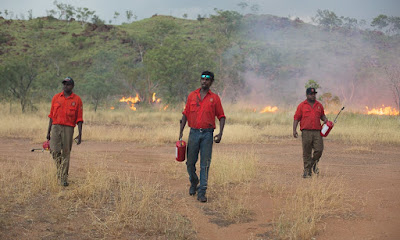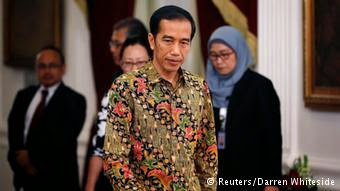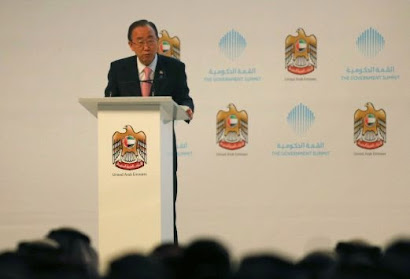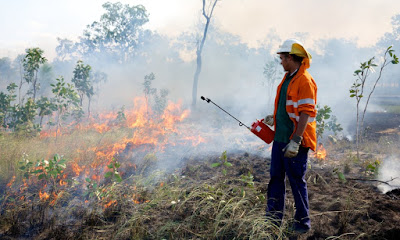Traditional
knowledge has already reduced bushfires and emissions in the top end, so why
isn’t it used more widely?
 |
| Kija Rangers conduct prescribed burning in the East Kimberley in 2019. Photograph: Supplied/Kimberley Land Council |
Indigenous
fire practitioners have warned that Australia’s bush will regenerate as a “time
bomb” prone to catastrophic blazes, and issued a plea to put to use traditional
knowledge which is already working across the top end to reduce bushfires and
greenhouse gas emissions.
“This is a
time bomb ticking now because all that canopy has been wiped out,” says Oliver
Costello of the national Indigenous Firesticks Alliance.
“A lot of
areas will end up regenerating really strongly, but they’ll return in the wrong
way. We’ll end up with the wrong species compositions and balance.
“That’s why we need to get Indigenous fire
practices out into the landscape in the coming months, to start to read the
country and look at areas that need restoration burning in the short term.”
As
Australia comes to terms with this season’s catastrophic fires, Indigenous
practitioners like Costello are advocating a return to “cultural burning”.
What is cultural
burning?
Small-scale
burns at the right times of year and in the right places can minimise the risk
of big wildfires in drier times, and are important for the health and
regeneration of particular plants and animals.
Different
species relate to fire in different ways, Costello explains. Wombats, for
example, dig burrows to escape, while koalas climb into the canopy.
“When you
understand the fire relationships they have, their own fire culture, then you
are really applying the right fire for that culture so that you’re supporting
the identity of that place.
“When you
do that, you get more productive landscapes, you get healthier plants and
animals, you get regeneration, you discourage invasive elements, which are
sometimes native species that might belong in the system next door.
“It’s so
important to apply that right fire for right country, so you can maintain the
right balance.”
Dr David
Bowman is a professor of pyrogeography and fire science at the University of
Tasmania. Bowman describes Indigenous fire management as “little fires tending
the earth affectionately”.
“The
affectional is the opposite of mechanical. It’s with emotion. So it can be
reverence, affection, fear, a whole range of emotions, but it’s an emotional
relationship you have with land using fire to create mosaics and flammable
habitat mosaics, which are really good for biodiversity and a really good way
of managing fuel load.”
Where is it
used in Australia?
In northern
Australia, Indigenous land ownership is widespread. Caring for country and
ranger programs in protected areas has delivered a degree of autonomy to
traditional owners to walk the country, burning according to seasonal need and
cultural knowledge.
Indigenous
fire management involves “cool” fires in targeted areas during the early dry
season, between March and July. The fires burn slowly and in patches.
In the
Kimberley, the Land council holds community fire planning meetings throughout
the early dry season to ensure the correct people are burning their country.
“Traditional
owners are consulted and native title holders design burn lines and fire walk
routes,” the KLC acting CEO Tyronne Garstone says.
“These burn
lines are approved by the group and Indigenous rangers perform the on-ground
work, backed up by modern technology with rangers taking constant weather readings
and recording the conditions of the day.
“They work
very well at combining the old people’s fire practices with modern techniques.”
Even so,
climate change is affecting their ability to do “right way” fire management,
Garstone says.
“These
‘right way’ fire days are getting fewer and fire behaviour is changing along
the same lines as over east. Late season conditions are also driving more fires
in unusual ways due to the climatic conditions we are currently facing.”
 |
| Kija Rangers conduct prescribed or ‘cool’ burning in the East Kimberley in the dry season, 2019. Photograph: Supplied/Kimberley Land Council |
How
effective is it?
The Darwin centre for bushfire research at Charles Darwin University maps bushfires
weekly. Since traditional burning was reintroduced on a large scale, the centre
has collected enough data to show that the area of land destroyed by wildfires
has more than halved, from 26.5m hectares in 2000, to just 11.5m hectares in
2019.
“We have
annual fires up here,” the centre’s research fellow Andrew Edwards says. “Forty
per cent of the top end could burn every year. So we had to do something about
that.”
“We were
originally much more interested in biodiversity, Aboriginal employment and
getting people back on country to manage it properly, but when the carbon
economy came along we saw a way to manage fire to abate greenhouse gas
emissions.
“It was
pretty bad before that happened,” Edwards says. “It was just fires running wild
across huge tracts of north Australia that nobody was doing anything about.”
Edwards
says the top end cooperative model can be adapted to southern conditions.
“That’s
what needs to be looked at. Obviously there’s a lot more infrastructure to set
up, but it’s collaboration and education.
“If we want
to manage our natural environment properly, we need to be doing prescribed
burning. There’s so much cultural knowledge out there still, and it’s being
totally ignored. There’s hundreds of Indigenous rangers out there now doing
this work.”
Will these
practices be widely adopted?
In southern
Australia, Oliver Costello says, Aboriginal knowledge systems are far less
valued but hold important solutions.
The Coag
national bushfire management policy includes a commitment to “promote
Indigenous Australians’ use of fire”, but Indigenous fire groups like
Firesticks Alliance say they need more resources to build capacity.
“There are
a lot of policy settings at a high level that support us, but there’s nothing
in between. There’re no resources,” Costello says.
“There’s no
investment really outside of northern Australia Indigenous fire management of
any significance, and they had to build a whole new economy to support it
through carbon.
“There’s
always investment going into future firefighting capacity, more trucks, more
helicopters, more this, more that. What we need is people getting out into the
landscape now, with the knowledge to start to heal it.
 |
| A small cool burn managed by Indigenous firesticks alliance. Photograph: Firesticks Alliance Indigenous Corporation/PA |
Professor
Bowman says it is possible to “blend Aboriginal with European and modern
scientific approaches to create an opportunity for all land users and land
owners”.
He suggests
small-scale local “Green fire” groups modelled on the Landcare program.
“I would
like to see a crossover between Indigenous and mainstream fire management
groups, where there can be exchange and recognition.
“Because in
the end there’s two things which are important to [remember]: all humans have
come from a fire management background in their cultures, it’s just that some
cultures ended up obliterating that knowledge because of industrialisation.
“We should
really prioritise employment of Aboriginal people. But when there’s a gap we
could be filling that gap with community groups. And there’s a really good
opportunity for Aboriginal people to be involved in training.
“We need to
encourage and promote the philosophy of Aboriginal fire practice because that’s
going to be a really important pathway for sustainable fire management and also
for healing because so many communities have been traumatised and shocked by
the scale of the burning.”
Costello
says the areas that haven’t burned this time around are now even more
vulnerable.
“They are
critical parts of the landscape [that need] to be able to support the animals
and plants that have survived. And so those areas are going to be under
increasing pressure and they’re also at risk of a future fire.
“There was
an economy before settlement that supported this, a resource economy based on
people looking after the land and having all that they needed.
“Now in the
modern society it revolves around money. So we need to build economies that
support cultural practice and acknowledge traditional custodianship.
“There’s
all this canopy that’s been burnt away. We’ve got knowledge and techniques that
can help heal that country in the future. It’s going to take some time. We’ve
got probably two or three years before we can really be effective in some of
that country because it needs to recover. But if we don’t get in there after
that, then we miss our chance.”
Related Articles:
The much welcomed rain in Australia might be too much of a good thing, as flash floods were reported in some area https://t.co/rNjVYeiU9T pic.twitter.com/Bgml3Yz50f— AFP news agency (@AFP) January 18, 2020
Related Articles:
(*) Kryon explains what is going on with the Weather/Climate Change
(**) Kryon gives Australia fire suggestions













